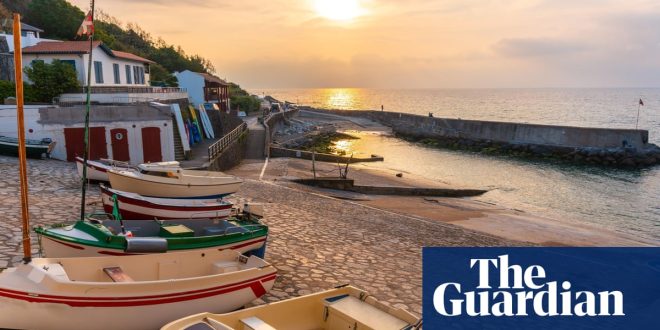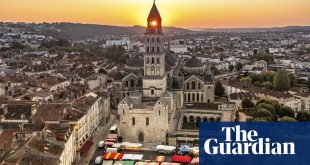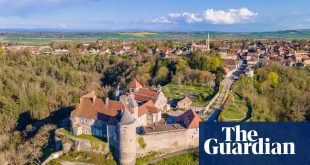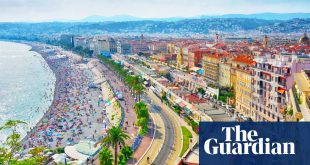Guéthary, Basque coast
Between the glamour of Biarritz and the tuna boats and half-timbered houses of Saint-Jean-de-Luz lies a surprisingly peaceful stretch of the French Basque coast, with relatively few tourists even in high summer.
“It’s the crashing waves of the Atlantic that save us from the invasions,” says Amaia Urruty, who has been coming to Guéthary since she was a teenager. “Everything is calm here except the sea.”
Life in Guéthary centres on the fronton, the huge court for games of Basque pelota in front of the village hall that is also a venue for markets, dances and fairs. Once a whaling centre, the port is remarkable today for the way its fishing boats are hauled on to dry land every day rather than left in the water. The buildings are beautifully kept and typically Basque – white facades with long, sloping roofs, dark-red shutters. “Once you start coming here, you return every year,” she says. “It’s great for families and people who love the Basque style.”
The beaches are fantastic – long and sandy – and there are plenty of places to enjoy traditional pipérade aux oeufs (omelette with tomatoes, peppers and ham from nearby Bayonne) or a panaché de fruits de mer (seafood platter) overlooking the fishing boats in the tiny port. “It’s fun to watch the surfers and, beyond them, see the Spanish Basque coast,” says Urruty.
At nearby Bidart, Plage d’Erretegia is a sandy bay accessed by a narrow path between the dunes and is the start of a coastal footpath to Hendaye – and the Spanish border – 15 miles away. Further south, Plage de l’Uhabia is wider and good for swimming, while Plage de Parlementia is the big one for surfers and the only beach with lifeguards all summer long. Plage des Alcyons is the best one for families: at low tide, the rock pools become mini aquariums of sea urchins, crabs, prawns and tiny mussels.
Two miles from Bidart is the Moulin de Bassilour, a bakery which specialises in gâteau basque – a pie filled with rum-flavoured crème pâtissière or black cherries. Here visitors can see the wheat being stone-ground, powered since 1741 by the creaking water wheel next door. There’s a café-restaurant but it’s better to stock up on picnic supplies and head for an excursion inland – Guéthary’s hire agency, Velektrix, rents e-bikes from €21 for half a day.
To the south-west is Espelette, known for its red chillies seen drying on house fronts and balconies during the summer, while in neighbouring Cambo-les-Bains, Villa d’Arnaga, the Basque-style museum-house of Edmond Rostand, author of Cyrano de Bergerac, displays some of his sketches and poems. To finish the day, the honeypot village of Ainhoa is a 20-minute e-bike ride away. It can get busy by day, but on summer Mondays the village hall organises a night-time hike – La Nocturne d’Ainhoa – to its hilltop chapel.
Stay Guéthary’s old village school has been converted into the three-star Hotel Balea (doubles from €79), with 28 rooms and breakfast served in the interior garden
Jon Bryant
Vienne, Auvergne-Rhône-Alpes
The ruins of medieval Château de la Batie, looking like a holey cardboard cut-out on the skyline north of town, is always the first thing that catches my eye in Vienne. It’s in such a state of disrepair that visitors would be forgiven for thinking it’s the oldest building in these parts, but they would be wrong: Vienne’s Roman architecture predates it by more than a thousand years.
Think of the ancient Romans’ legacy in France and the spectacular Pont du Gard aqueduct will probably spring to mind, or perhaps the Maison Carrée temple in Nîmes or the spectacular amphitheatre at Arles. Sleepy Vienne, 20 miles south of Lyon, with a population today much the same as it was two millennia ago – a mere 30,000 – will barely get a look in.
The ancient ruins are woven into the fabric of this town on the banks of the Rhône, once capital of the Gallic Allobroges tribe until it was turned into a Roman colony under Julius Caesar in 47BC.
Dogs play around the arches of the Jardin de Cybèle, the remains of the Roman forum. I sip coffee at Le Bar du Temple, overlooking the Temple of Augustus and Livia. Thomas Jefferson visited Vienne in 1787 and the temple is said to be the inspiration behind his design for the White House of the Confederacy in Richmond, Virginia.
Built many centuries later, cylindrical towers sprouting like fat straws in the streets around the temple reveal the presence of traboules, covered passages similar to those found in Lyon, 20 miles to the north.
The centuries slowly obscured much of the Roman heritage until vast mosaics were unearthed at Saint-Romain-en-Gal in 1891. Sections of the mosaic are on display at the Musée de Saint-Romain-en-Gal, including a newly renovated area depicting the agricultural seasons. The detail is minute, every stripe visible on Dionysus’s tiger in one square, every grape being trodden by harvest workers in the next.
Jazz arrived in Vienne more than 2,000 years after the Romans, and now, for three weeks of the year, it transforms the town. When Jean-Paul Boutellier decided to establish an international jazz festival in 1981, he had originally planned to hold it in Parc de la Tête d’Or, a riverside garden on the northern edge of Lyon. The city council overruled him for fear of upsetting the resident zoo animals, and Vienne, quite by accident, became home to one of France’s best-known jazz festivals. Held in the Roman théâtre antique, Jazz à Vienne (late June to mid July) has hosted some of the biggest names in the industry, including Ella Fitzgerald, Norah Jones and Miles Davis. Outside festival time, the theatre is free to visit on the first Sunday of each month.
Boutellier fused jazz and Vienne’s Roman history even further earlier this year when he opened a jazz club within the Musée de Saint-Romain-en-Gal, with views of the river and the castle. Concerts are held every other Sunday evening, increasing to weekly from September.
The vines that run down the hillside are the Romans’ living legacy in Vienne, and Vitis Vienna is a collective of revived Roman vineyards (call any of the wineries directly to visit). I enjoy my own Crozes-Hermitage in modern surroundings, at the newly opened wine bar Ô BievVin.
Stay La Péniche Bed & Bicycle (doubles from €149) is one of three self-catering barges on the Rhône overlooking Vienne and its vineyards, with a hot tub on deck
Anna Richards
Côte Bleue, near Marseille
“I’ve never been as happy as when I was in La Redonne,” wrote Blaise Cendrars in 1927. The words of the Marseille-based writer ring true as I hike red rocks between green pines and the azure sea. Like many marseillais before me, I’ve come to the Côte Bleue to escape the city and explore the tiny villages of this enchanting coastline.
The Côte Bleue unfurls along the Mediterranean north-west of Marseille. Stretching for 17 miles, it is on a more intimate scale than the vast 5,000-hectare Calanques national park to the south of city. Like the better-known area, the Côte Bleue also has a chain of calanques (rocky inlets), and villages that give a glimpse of simple southern living. They can now be toured on foot thanks to 18th-century smugglers and 20th-century railway engineers.
The Sentier des Douaniers (customs officers’ trail) was built during the French Revolution for officials (douaniers) to patrol the coastal path checking for smugglers out at sea. Hikers using it today encounter a kaleidoscope of nature – verdant flora, the cerulean sea, and ochre and white rocks – and an epic panorama. Clinging to the cliffs, the jagged trail offers a good cardio workout.
The Train de la Côte Bleue is a more leisurely option. Launched in 1915, it allows commuters and tourists to soak up breathtaking vistas while traversing 18 stone viaducts. It’s easy to hop on and off at the old tiled stations. I prefer to do this coast on a mix of trails and train.
Wearing non-slip shoes, I board an 8am train at Marseille’s Saint-Charles station. Seats on the left side give the best view as we whiz past container ships and the red-tiled roofs that Cézanne painted in the L’Estaque neighbourhood. As we leave the city limits, the urban sprawl dissolves into the Mediterranean’s endless blue.
I hop off at the tiny port of Niolon to hike to Ensuès-La Redonne, a 4½-mile walk that takes 2½ hours (compared with the train’s six minutes). At Niolon station, the Train Inc Café sells picnic grub with a side of social impact. Beside the port, the vine-canopied terrace of seafood restaurant La Pergola is ideal for a lingering meal. But I’m on a mission to hike.
With the train tracks on my left, I set off on the Sentier des Douaniers, weaving between fragrant pines and bursts of poppies. A stone viaduct soars above the Calanque du Jonquier, a tiny blue cove. Further along the trail, I take a refreshing dip at the bigger Calanque de l’Erevine.
The limestone cliffs give way to rocks in 50 shades of ochre as I descend into Méjean via a natural staircase, passing people playing a game of Provençal pétanque. Lined with old cabanons (fishers’ cottages), the tiny harbour is dwarfed by a towering viaduct. Beneath it, the casual Mange Tout restaurant fries up thousands of whitebait daily to the delight of locals and tourists. The rest of the route to Ensuès-la-Redonne is a paved road, which is less picturesque but easier on the feet.
Back on the train, it is a quick ride to the popular seaside town of Sausset-les-Pins. Once a hub for tuna fishing, it now has a lovely harbour filled with pleasure boats, shops and restaurants, and a mix of sun-soaked beaches. I have arrived in time for the Sunday market, where local foodstuffs are sold beside inexpensive clothes and bric-a-brac. I pick up a Provençal olive-studded fougasse bread and head along the coastal boardwalk for a nap at Plage du Petit Nid.
The last stop on the Côte Bleue is Martigues, which has earned the nickname of the “Venice of Provence” for its picturesque canals. They are at their photogenic peak in the Quartier de l’Ile, where pastel houses and traditional coloured wooden boats are reflected in the mirror-like water. I check out the baroque Saint Marie-Madeleine church, then take a stroll through Martigues, stopping off to taste poutargue – cured mullet roe, similar to Italian bottarga – whose briny punch smacks of the south. It’s on sale at the Domaines des Terroirs market or direct from the sea at Lou Calens, the last producer to use calens (traditional fishing nets).
On the cinematic journey back to Marseille I am reminded of a quote I saw painted on rocks on the coastal trail. “There’s no direct path to happiness. Happiness comes from taking the path.”
Trains run every hour from Marseille-Saint-Charles until around 8pm. Journey time to Niolon 25 minutes, to Martigues 55 minutes
Alexis Steinman
Brignogan-Plages, Brittany
There are many Francophiles to be found on the south coast of Brittany, where the golden sand beaches at Carnac and Bénodet are popular for family camping and beach holidays. The region’s south coast is easy to reach after arriving at Saint-Malo or Roscoff by ferry and driving across the peninsula, yet with school holidays in August, it can get busy. To reach a more peaceful corner of Brittany, it’s wiser to head west from the ferry instead, to the north coast of Finistère.
West of Roscoff, the sweeping blond beaches of the Côte des Sables (the sandy coast) are much less frequented than their southern counterparts, but equally alluring. We happened upon it a few years ago, when my curiosity for parts unknown saw us travel along the coast towards Le Conquet.
We stayed a few nights at Hotel de la Mer in Brignogan-Plages, a resort on a gently looped coastline with many beaches to choose from. The hotel is by the water at Plage des Chardons Bleus, whose white sand is punctuated at low tide by silver-grey boulders. Elsewhere, sheltered Plage du Garo is overlooked by stately umbrella pines and the water that fills the bay at high tide is turquoise. Just around the corner, Plage du Phare sweeps around towards the whitewashed Pontusval lighthouse, perched on the rocks.
Heading back east along the coast, we came to Plage des Amiets at Cléder – a wide, sweeping curve of golden sand backed by moorland and a windswept campsite. On a sunny Saturday in August, we shared the beach with just a few families; some were paddleboarding on the incoming tide while others played tennis or just lounged around. I stood in the shallows watching my two children paddle. Around me, wetsuit-clad foragers gathered edible seaweed from the rocks, and I was transfixed by the ribbons and frills that fluttered around my feet in the water like an octopus’s garden.
We’d taken a picnic, as there are no shops or cafes for miles, but it made a perfect lunch as we basked in the sun. Afterwards, we parked in the village square in Plouescat, bought ice-creams from the shop and marvelled at the huge 16th-century market hall, sorry that we’d missed that morning’s market.
During another trip to the area, I discovered the beach at Keremma, near Plouescat. It had caught my eye from the window of La Butte, an eco-friendly hotel high on the hill at Plouider, where chef Nicolas Conraux’s cuisine draws on the area’s abundance of top-quality produce. With a slightly bleary head from a sensational meal the night before, I strolled on to the beach as the green-hued sea lapped gently to the shore, covering the patterns of seaweed. A murmuration of small seabirds twirled against a sky streaked with wisps of cloud. I had the beach entirely to myself. When there are quiet corners like this to be found, why follow the crowds?
Stay Hotel de la Mer has doubles from €150 room-only; La Butte has doubles from €135 room-only
Carolyn Boyd
 Top Naija News – Nigeria News, Nigerian News & Top Stories Top Naija News – Nigerian Newspapers, Nigerian News. topnaijanews is a daily Nigerian newspaper covering Latest News, Breaking News, Entertainment, Sports, Lifestyle and Politics.
Top Naija News – Nigeria News, Nigerian News & Top Stories Top Naija News – Nigerian Newspapers, Nigerian News. topnaijanews is a daily Nigerian newspaper covering Latest News, Breaking News, Entertainment, Sports, Lifestyle and Politics.




